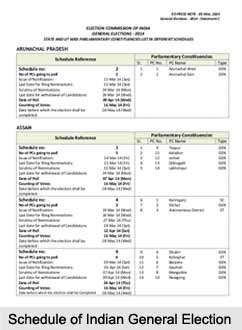 Time of Elections in India is determined by the Election Commission of India keeping in mind a number of factors. Elections for the Lok Sabha and every State Legislative Assembly have to take place every five years, unless called earlier. The Indian President can dissolve Lok Sabha and call a general election before five years is up, if the government can no longer command the confidence of the Lok Sabha, and if there is no alternative government available to take over. Governments have found it increasingly difficult to stay in power for the full term of a Lok Sabha in recent times, and so elections have often been held before the five-year limit has been reached. When the five-year limit is up, or the legislature has been dissolved and new elections have been called, the Election Commission of India puts into effect the machinery for holding an election. The constitution states that there can be no longer than 6 months between the last session of the dissolved Lok Sabha and the recalling of the new House, so elections have to be concluded before then. A constitutional amendment passed in 1975, as part of the government declared emergency, postponed the election due to be held in 1976. This amendment was later rescinded, and regular elections resumed in 1977. Holding of regular elections can only be stopped by means of a constitutional amendment and in consultation with the Election Commission of India, and it is recognised that interruptions of regular elections are acceptable only in extraordinary circumstances.
Time of Elections in India is determined by the Election Commission of India keeping in mind a number of factors. Elections for the Lok Sabha and every State Legislative Assembly have to take place every five years, unless called earlier. The Indian President can dissolve Lok Sabha and call a general election before five years is up, if the government can no longer command the confidence of the Lok Sabha, and if there is no alternative government available to take over. Governments have found it increasingly difficult to stay in power for the full term of a Lok Sabha in recent times, and so elections have often been held before the five-year limit has been reached. When the five-year limit is up, or the legislature has been dissolved and new elections have been called, the Election Commission of India puts into effect the machinery for holding an election. The constitution states that there can be no longer than 6 months between the last session of the dissolved Lok Sabha and the recalling of the new House, so elections have to be concluded before then. A constitutional amendment passed in 1975, as part of the government declared emergency, postponed the election due to be held in 1976. This amendment was later rescinded, and regular elections resumed in 1977. Holding of regular elections can only be stopped by means of a constitutional amendment and in consultation with the Election Commission of India, and it is recognised that interruptions of regular elections are acceptable only in extraordinary circumstances.
The Election Commission of India normally announces the schedule of elections in a major Press Conference a few weeks before the formal process is set in motion. The Model Code of Conduct for guidance of candidates and Political Parties immediately comes into effect after such announcement. The formal process for the elections starts with the Notification or Notifications calling upon the electorate to elect Members of a House. As soon as Notifications are issued, Candidates can start filing their nominations in the constituencies from where they wish to contest. These are scrutinised by the Returning Officer of the constituency concerned after the last date for the same is over after about a week. The validly nominated candidates can withdraw from the contest within two days from the date of scrutiny. Contesting candidates get at least two weeks for political campaign before the actual date of poll.
Factors in Scheduling Elections in India
In a country as huge and diverse as India, finding a period when elections can be held throughout the country is not simple. The Election Commission, which decides the schedule for elections, has to take account of the weather - during winter constituencies may be snow-bound, and during the monsoon access to remote areas restricted -, the agricultural cycle - so that the planting or harvesting of crops is not disrupted, exam schedules - as schools are used as polling stations and teachers employed as election officials, and religious festivals and public holidays. On top of this there are the logistical difficulties that go with holding an election - sending out ballot boxes or Electronic Voting Machines, setting up polling booths, recruiting officials to oversee the elections.
On account of the vast magnitude of operations and the massive size of the electorate, polling is held at least on three days for the national elections. A separate date for counting is fixed and the results declared for each constituency by the concerned Returning Officer. The Commission compiles the complete list of Members elected and issues an appropriate Notification for the due Constitution of the House. With this, the process of elections is complete and the President, in case of the Lok Sabha, and the Governors of the concerned States, in case of State Legislatures, can then convene their respective Houses to hold their sessions. The entire process takes between 5 to 8 weeks for the national elections, 4 to 5 weeks for separate elections only for Legislative Assemblies.




















